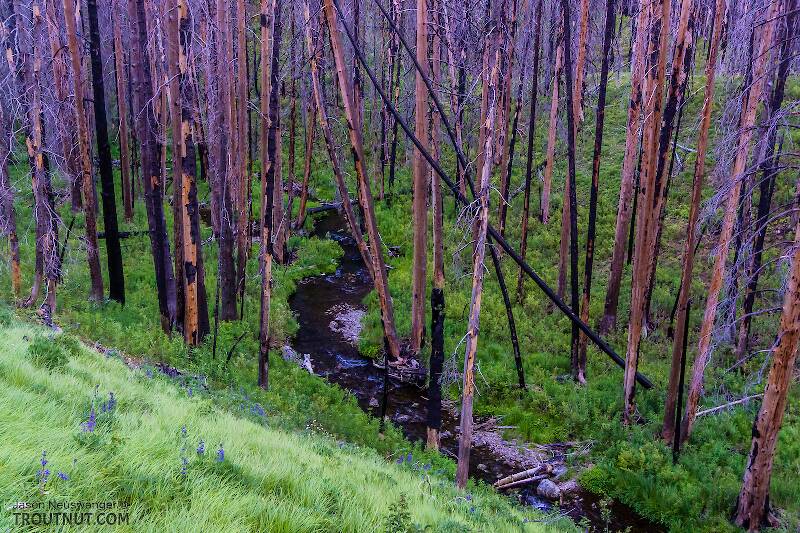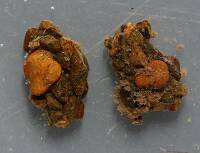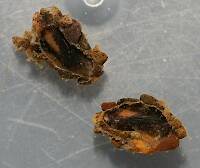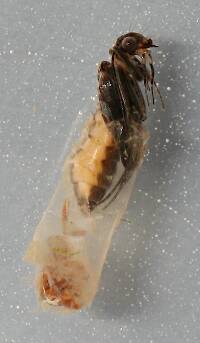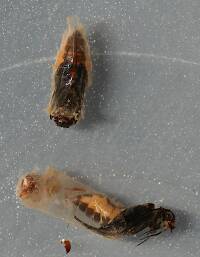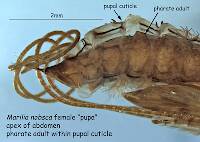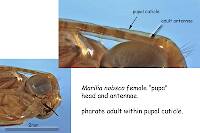
Blue-winged Olives
Baetis
Tiny Baetis mayflies are perhaps the most commonly encountered and imitated by anglers on all American trout streams due to their great abundance, widespread distribution, and trout-friendly emergence habits.
Featured on the forum

This specimen appears to be of the same species as this one collected in the same spot two months earlier. The identification of both is tentative. This one suffered some physical damage before being photographed, too, so the colors aren't totally natural. I was mostly photographing it to test out some new camera setting idea, which worked really well for a couple of closeups.

Troutnut is a project started in 2003 by salmonid ecologist Jason "Troutnut" Neuswanger to help anglers and
fly tyers unabashedly embrace the entomological side of the sport. Learn more about Troutnut or
support the project for an enhanced experience here.
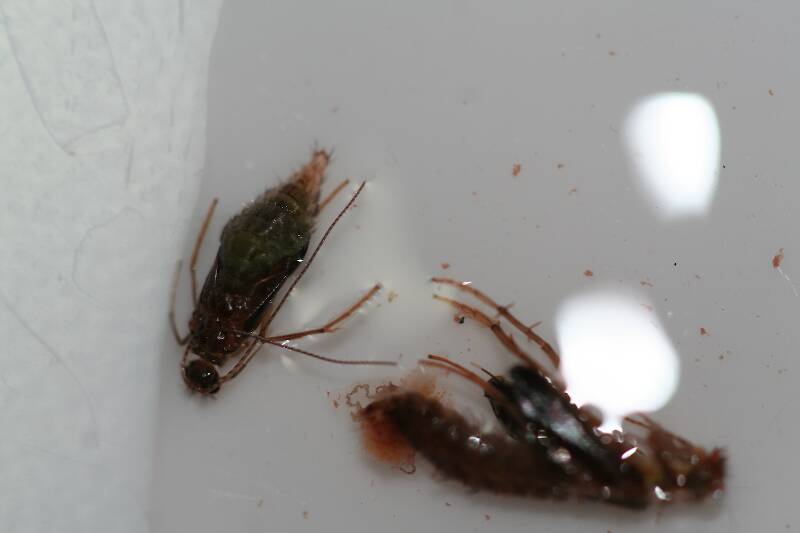
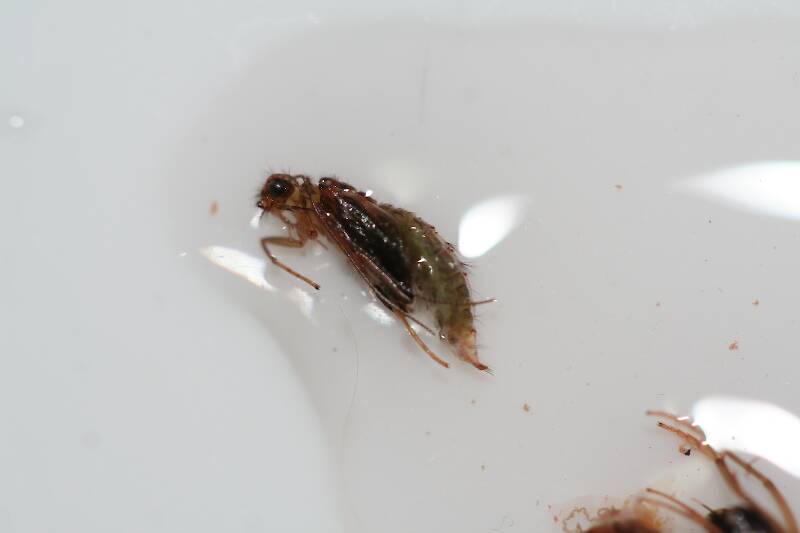
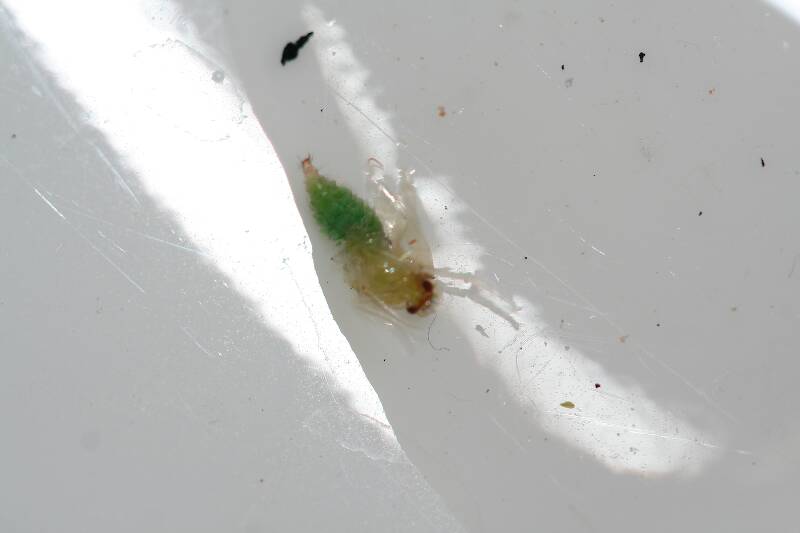
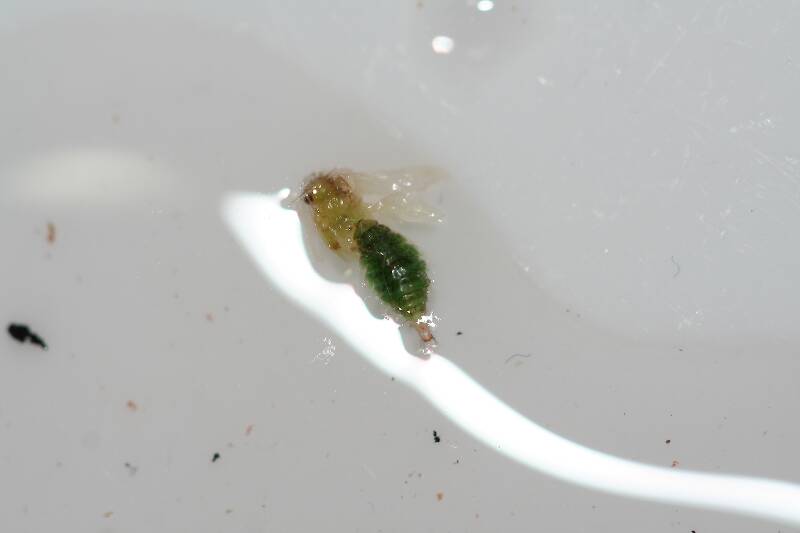
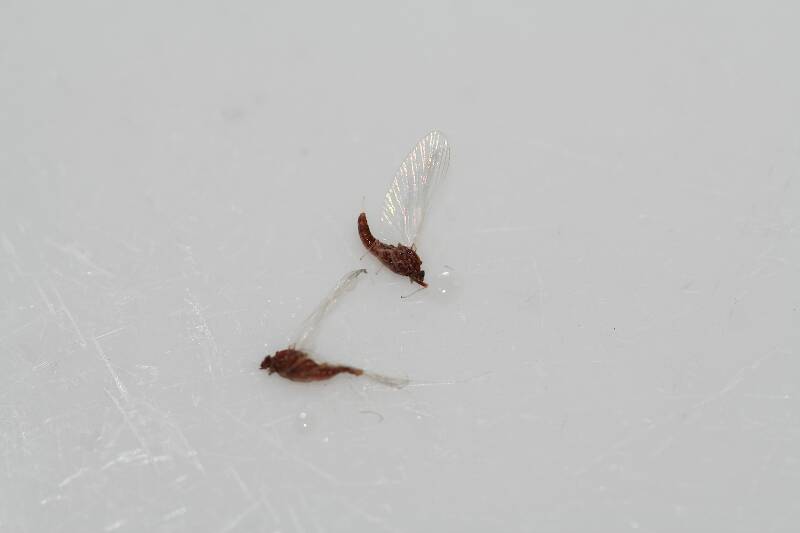
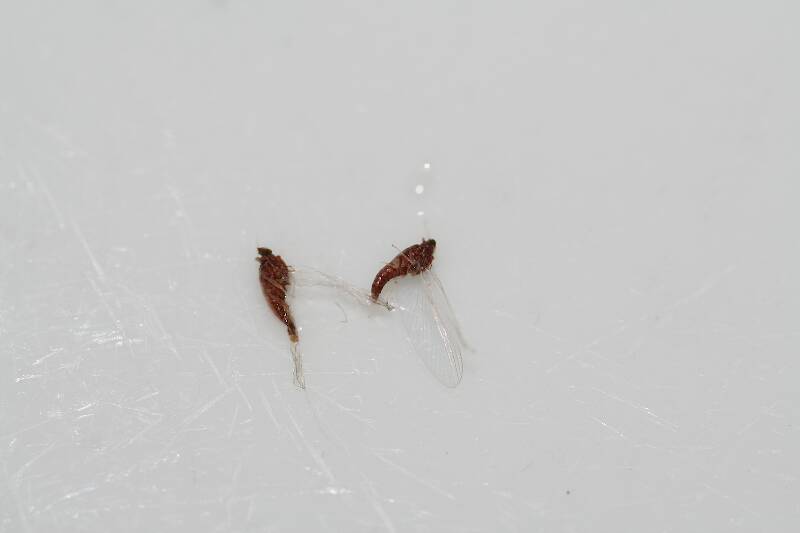
Shawnny3 on Jul 16, 2012July 16th, 2012, 6:12 am EDT
Here are a few bugs I collected last night. Incidentally, this was the first time I've fished a diving caddis with success. There were lots of pupal shucks in the film when I arrived, and adults coming off the water. I saw a nice fish in deep, fast water, thrash the surface violently. Whether the adults were hatching or laying eggs I wasn't sure, so I put on a pupa and a hackle-less dry. I put split shot a few feet up the leader, in hopes that it would pull the dry slowly down through the water column. The pupa caught nothing (I didn't have one in the color I think I needed), but the dry did quite well, hooking nearly every fish I caught (I also picked up a few nice fish on a baetis nymph). Almost every fish caught on the diving adult was in skinny, open water, typically slower water than I usually like to nymph, and was very small (other than a 13-incher, they averaged about 5 inches, while the average fish in this stream normally goes 9-10 inches). Perhaps that had to do with the fish feeding in that way in lies that small fish tend to occupy. The fish hit the sunken dry really hard, as though they were expecting it to make a quick getaway.
I've got to get a better assortment of wet flies for this type of fishing. Time to hit the vise. I was just happy to find something that worked when obvious caddis activity was going on and I wasn't terribly well prepared for it.
-Shawn
I've got to get a better assortment of wet flies for this type of fishing. Time to hit the vise. I was just happy to find something that worked when obvious caddis activity was going on and I wasn't terribly well prepared for it.
-Shawn
Jewelry-Quality Artistic Salmon Flies, by Shawn Davis
www.davisflydesigns.com
www.davisflydesigns.com
Crepuscular on Jul 16, 2012July 16th, 2012, 11:53 am EDT
Nice photos Shawn! I really enjoy fishing caddis sometimes, other times not so much, but when they are eating them on the swing the takes are vicious! I like it...Were you getting them to eat dead drifting the fly or down and across on the swing?
Eric
Eric
Shawnny3 on Jul 16, 2012July 16th, 2012, 11:57 am EDT
Dead-drift, upstream presentation. I would jiggle it at the end of the drift, but I got zero hookups that way. Every strike was upstream, after a very short (if any) drift.
-Shawn
-Shawn
Jewelry-Quality Artistic Salmon Flies, by Shawn Davis
www.davisflydesigns.com
www.davisflydesigns.com
Martinlf on Jul 16, 2012July 16th, 2012, 1:56 pm EDT
I can see you're working on your SC Ph.D., to match the degrees of most of the fish over your way. Nice work!
"He spread them a yard and a half. 'And every one that got away is this big.'"
--Fred Chappell
--Fred Chappell
Shawnny3 on Jul 16, 2012July 16th, 2012, 5:22 pm EDT
I can see you're working on your SC Ph.D.
Unfortunately, my dissertation has been rejected many times. It's always something: Too much tension, too much slack, too heavy a 7x tippet, micro-drag, size-20 fly too big or the wrong color... picky, picky. Perhaps Dr. Martin or Dr. Ripepi could put in a good word to the committee for me, or at least help me with my editing.
-Shawn
Jewelry-Quality Artistic Salmon Flies, by Shawn Davis
www.davisflydesigns.com
www.davisflydesigns.com
Entoman on Jul 23, 2012July 23rd, 2012, 7:50 pm EDT
Hi Shawn,
The baetids look to be Acentrella turbida female imagos (Tiny Brown Quill Spinners). The stout little bodies, lack of hind wings, and mesonotal projections are indicative.
The big caddis pupa looks like Hydropsyche (Spotted Sedge) and the smaller olive one looks like Cheumatopsyche (Little Sister Sedge) to me. The tiny chartreuse one isn't a Microcaddis (wrong morphology), but probably one of the other fixed retreat making families of the Hydropsychoidea, closely related to the bigger ones. It's my understanding that some of them can be pretty small, but with the same kind of butt.
Little Sister Sedge pupa tend to dead drift quite a distance just under the surface before emerging very quickly (at least that's what they do out here). When they are near the surface half out of their shucks, stuff is sticking out all over the place. Though the size of the fish is definitely a mitigating factor, perhaps these two characteristics explain the success of your dead drifted sunken dry fly?
Regards,
The baetids look to be Acentrella turbida female imagos (Tiny Brown Quill Spinners). The stout little bodies, lack of hind wings, and mesonotal projections are indicative.
The big caddis pupa looks like Hydropsyche (Spotted Sedge) and the smaller olive one looks like Cheumatopsyche (Little Sister Sedge) to me. The tiny chartreuse one isn't a Microcaddis (wrong morphology), but probably one of the other fixed retreat making families of the Hydropsychoidea, closely related to the bigger ones. It's my understanding that some of them can be pretty small, but with the same kind of butt.
Little Sister Sedge pupa tend to dead drift quite a distance just under the surface before emerging very quickly (at least that's what they do out here). When they are near the surface half out of their shucks, stuff is sticking out all over the place. Though the size of the fish is definitely a mitigating factor, perhaps these two characteristics explain the success of your dead drifted sunken dry fly?
Regards,
"It's not that I find fishing so important, it's just that I find all other endeavors of Man equally unimportant... And not nearly as much fun!" Robert Traver, Anatomy of a Fisherman
Martinlf on Jul 24, 2012July 24th, 2012, 9:56 am EDT
Shawn, I'm more than happy to put in a good word for you. Unfortunately, I have very little pull with that committee, and the members have ignored me entirely more than once.
"He spread them a yard and a half. 'And every one that got away is this big.'"
--Fred Chappell
--Fred Chappell
PaulRoberts on Jul 24, 2012July 24th, 2012, 10:00 am EDT
Little Sister Sedge pupa tend to dead drift quite a distance just under the surface before emerging very quickly (at least that's what they do out here). When they are near the surface half out of their shucks, stuff is sticking out all over the place.
Ditto in the East too. I still have some of my first Cheumo ties I hastily whipped up after dark one evening alongside the Delaware, after seeing those little chartreuse pupae drifting in the surface film, with trout taking them greedily.
Entoman on Jul 24, 2012July 24th, 2012, 1:38 pm EDT
Paul,
What do you think that little green number is? I don't remember ever seeing cream wingpads & thorax on a Little Sister before, but it sure looks to share the same morphology...
What do you think that little green number is? I don't remember ever seeing cream wingpads & thorax on a Little Sister before, but it sure looks to share the same morphology...
"It's not that I find fishing so important, it's just that I find all other endeavors of Man equally unimportant... And not nearly as much fun!" Robert Traver, Anatomy of a Fisherman
PaulRoberts on Jul 24, 2012July 24th, 2012, 5:09 pm EDT
I dunno, Kurt. Ames book talks about some caddis sp being VERY pale on emergence, then darkening. But those aren't Hydropsychidae.
The one's I'm referring to on the Big D looked like the pale one Shawn photo'd. I was told that they were Cheumo, but I agree the wings appear to lack any markings. I tied mine with Chartreuse floss,milky white translucent foam, and partridge hackle to drift in the surface film.
The one's I'm referring to on the Big D looked like the pale one Shawn photo'd. I was told that they were Cheumo, but I agree the wings appear to lack any markings. I tied mine with Chartreuse floss,milky white translucent foam, and partridge hackle to drift in the surface film.
Entoman on Jul 24, 2012July 24th, 2012, 8:13 pm EDT
Yeah, the brachycentrids (Grannom) are known for that. On the Lower Sac, I've captured pupal specimens with both super pale wings and almost black wings that I'm pretty sure are the same species, possibly in different phases of their emergence? They were virtually identical otherwise. Anyway, whatever this one is, the fly you describe sounds like good medicine to imitate it. Good idea about the foam - that should help hold it in the zone!
"It's not that I find fishing so important, it's just that I find all other endeavors of Man equally unimportant... And not nearly as much fun!" Robert Traver, Anatomy of a Fisherman
PaulRoberts on Jul 25, 2012July 25th, 2012, 6:59 am EDT
Yes, it was Brachycentrids Ames described and photo'd in his book.
As I remember it, the pupae I was imitating were right in the film, and there were good numbers of them. I was able to watch them drift by and netted a few.
As I remember it, the pupae I was imitating were right in the film, and there were good numbers of them. I was able to watch them drift by and netted a few.
Creno on Jul 26, 2012July 26th, 2012, 9:05 am EDT
Just like larvae all caddis pupae change colors with development. And as adults, right after emergence. I am sure you have all seen early instar larvae with cream colored abdomens while the last instar is often darker. Some if this is likely due to diet but last instar larvae develop globular fat bodies within the abdomen to carry them through pupation. These fat bodies often give the abdomen a mottled appearance when you look close.
The pupal wing cases are pale when the darker venation within has not developed yet. The dark wing case you see is the result of the dark veins of the adult showing through the pupal skin.
Most insect adults, including caddis, go through a "teneral" stage immediately after emergence from the pupal exuvia, The cuticle has not hardened and the coloration is paler than the final adult coloration. For the caddis that emerge from the stream surface it is this pale teneral coloration that the fish see during emergence. They don't fly all that well during this period as the wings have not fully hardened. The emerging caddis immediately tries to get to some structure where it can rest and let its cuticle harden. It is during this hardening period that the final, usually darker, patterned coloration appears.
The pupal wing cases are pale when the darker venation within has not developed yet. The dark wing case you see is the result of the dark veins of the adult showing through the pupal skin.
Most insect adults, including caddis, go through a "teneral" stage immediately after emergence from the pupal exuvia, The cuticle has not hardened and the coloration is paler than the final adult coloration. For the caddis that emerge from the stream surface it is this pale teneral coloration that the fish see during emergence. They don't fly all that well during this period as the wings have not fully hardened. The emerging caddis immediately tries to get to some structure where it can rest and let its cuticle harden. It is during this hardening period that the final, usually darker, patterned coloration appears.
PaulRoberts on Jul 26, 2012July 26th, 2012, 9:10 am EDT
Could Shawn's little pale caddis be a Brachycentrid? Are there any that small? Makes me wonder if that's not what I saw so many years ago on the Delaware.
Entoman on Jul 26, 2012July 26th, 2012, 9:40 am EDT
Thanks for the great explanation, Dave.
Paul -
The anal processes and aggressive taper of the abdominal segments look too Hydropsychoidea to me. I think we were closer to the mark with our original thoughts.
Paul -
Could Shawn's little pale caddis be a Brachycentrid?
The anal processes and aggressive taper of the abdominal segments look too Hydropsychoidea to me. I think we were closer to the mark with our original thoughts.
"It's not that I find fishing so important, it's just that I find all other endeavors of Man equally unimportant... And not nearly as much fun!" Robert Traver, Anatomy of a Fisherman
Creno on Jul 26, 2012July 26th, 2012, 12:30 pm EDT
could be lots of things - Micrasema is that small and can be quite abundant. With the glare on the photos I cannot really determine family.
Entoman on Jul 27, 2012July 27th, 2012, 10:39 am EDT
Here's a specimen whose photos are worth a look: http://www.troutnut.com/specimen/715
Besides showing a hydropsychid with pale wings, the commentary in the topic found below the pictures is very enlightening - particularly Creno's June 21st posts at 9am and 12:28pm... Fascinating!
Creno - Interpreting your remarks on this thread combined with what you had to say on the one I linked, caddis pupa can have pale wings in the pupal stage (the longest period) only getting darker as they progress through to the pharate stage in the last day or two, but that some species (particularly those known to drift for long periods at the surface prior to emergence) may stay pale and develop darker color as adults (as with some species of brachycentrid). Do I have this right? Also in the link, Gonzo mentioned some eastern species of cheumatopsyche as keeping pale wings as adults (something I didn't know), could that also be an explanation?
Shawn - The specimen looks either damaged or partially eccloded at the front end. Do you remember if you seined this critter from the surface drift (as I've been assuming) or did you remove it from a pupal case you found sampling the bottom?
Creno again - The partially formed wings on the right side have broken free from the pupal skin. Does their (wing) development offer any clues as to whether this is a pupa or pharate adult?
Besides showing a hydropsychid with pale wings, the commentary in the topic found below the pictures is very enlightening - particularly Creno's June 21st posts at 9am and 12:28pm... Fascinating!
Creno - Interpreting your remarks on this thread combined with what you had to say on the one I linked, caddis pupa can have pale wings in the pupal stage (the longest period) only getting darker as they progress through to the pharate stage in the last day or two, but that some species (particularly those known to drift for long periods at the surface prior to emergence) may stay pale and develop darker color as adults (as with some species of brachycentrid). Do I have this right? Also in the link, Gonzo mentioned some eastern species of cheumatopsyche as keeping pale wings as adults (something I didn't know), could that also be an explanation?
Shawn - The specimen looks either damaged or partially eccloded at the front end. Do you remember if you seined this critter from the surface drift (as I've been assuming) or did you remove it from a pupal case you found sampling the bottom?
Creno again - The partially formed wings on the right side have broken free from the pupal skin. Does their (wing) development offer any clues as to whether this is a pupa or pharate adult?
"It's not that I find fishing so important, it's just that I find all other endeavors of Man equally unimportant... And not nearly as much fun!" Robert Traver, Anatomy of a Fisherman
PaulRoberts on Jul 27, 2012July 27th, 2012, 12:03 pm EDT
That could explain it -Shawn's is an immature pupa.
Entoman on Jul 27, 2012July 27th, 2012, 4:12 pm EDT
Yeah that's how I'm leaning as well, but the blow-up shows the right wings sticking out in a stage of development that is perhaps too well developed for an immature pupa pulled from its sheath? Hopefully, Shawn will check in soon and tell us the collection method and Creno will shed some light on this.
"It's not that I find fishing so important, it's just that I find all other endeavors of Man equally unimportant... And not nearly as much fun!" Robert Traver, Anatomy of a Fisherman
Quick Reply
Related Discussions
Topic
Replies
Last Reply
40
Nov 23, 2015
by Martinlf
by Martinlf

